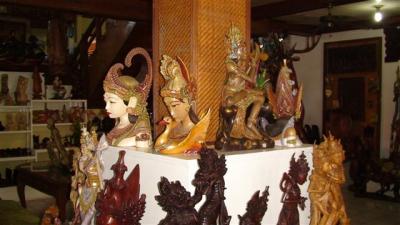Wayan picked us up at 0730 to continue our tour. We took a different route up to the mountains this time, but the scenery along the way was almost identical, with the narrow roads, neighborhoods of stores all selling the same product, and the Balinese style buildings with an occasional plot of land or forest peeking through.
Our first stop was at a wood carving shop called Manis The display area is enormous and the pieces are some of the most beautiful we have ever seen in our lives. We are talking award winning artistry here, the kind of work you pay hundreds of thousands for at home and brag about owning at cocktail parties. No exaggeration. It seriously looked more like an art museum than a shop. They offered goods ranging from small curio cabinet carvings, to statues and wall hangings, to furniture sets with matching couches, chairs, bar stools, tables and coffee tables. In the middle of the first floor display area there was a small team of people working away. You actually watched as a plain piece of wood took on a beautiful shape and marveled that the artist could see such a vision in a plain old piece of wood. There were people sanding and staining in addition to chiseling. The prices are outrageous by Indonesian standards, but a bargain by American standards.

While we looked around, we were followed by one of the staff who talked incessantly about each piece that we glanced at. At one point we Continue reading
